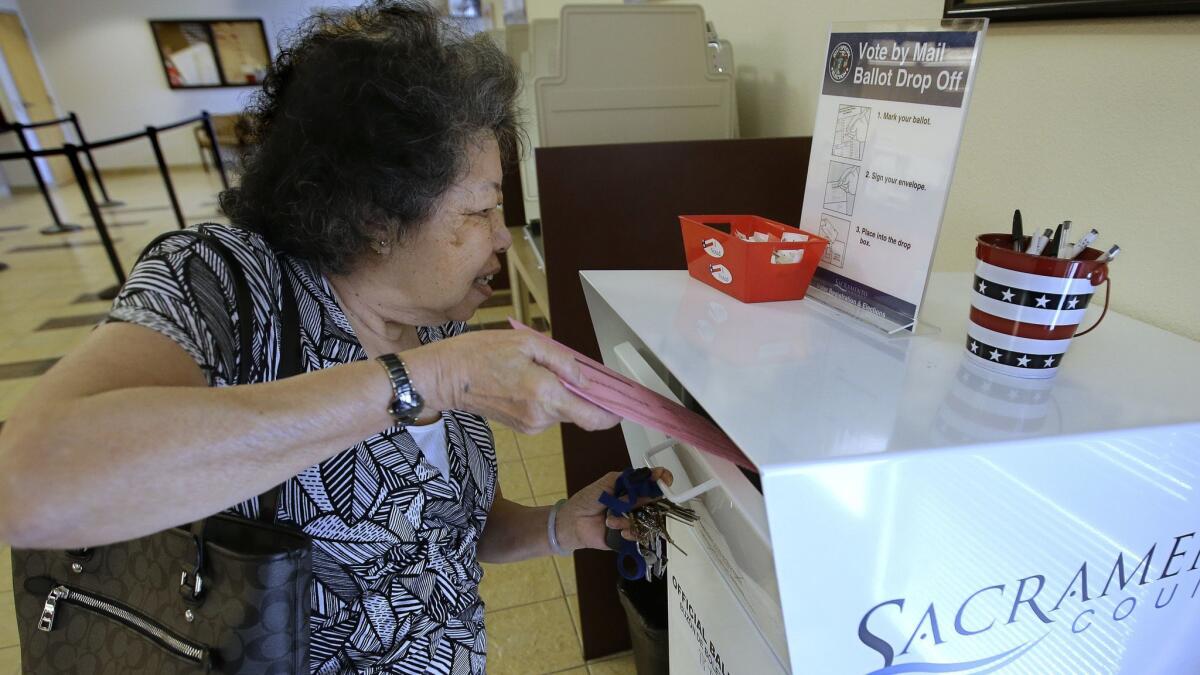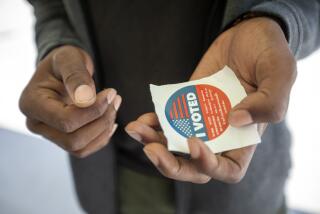In a handful of California counties, polling places are giving way to a sweeping new election system

- Share via
Reporting from Sacramento — The neighborhood polling place, a staple of American elections, has disappeared as election day arrives in five California counties — the first sites to transition to a sweeping new system dependent on absentee ballots and a limited number of all-purpose voting centers.
It is a major change, far beyond the tinkering in years past. And when it spreads to California’s most populous cities and communities in 2020, the new system probably will lead to a rethinking of what it means to conduct an election.
“Forget everything you know about the voting process and create an all-new one,” said Alice Jarboe, Sacramento County’s interim registrar of voters.
The new system, crafted by state lawmakers in 2016, is intended to give voters more choices on when and how they cast ballots. Supporters say a focus on a single day for elections makes little sense in the hustle and bustle of 21st-century lives.
The counting of California’s primary ballots will take time, and that’s as expected »
Dubbed the California Voter’s Choice Act, the law builds on two growing political realities. First, most voters already have migrated to voting by mail. Fifty-nine percent of ballots were cast somewhere other than a polling place in the 2016 primary. Two decades earlier, it was only 23%.
Second, voting equipment across California is rapidly aging and public dollars to replace it are scarce. In Sacramento County, the largest jurisdiction embracing the new system this year, some 550 neighborhood polling places have been replaced by 78 vote centers. All of the county’s 741,260 voters were mailed a ballot.
The law sets specific guidelines for the number of centers based on voter population. As election day approaches, additional locations are added to keep up with expected voter demand. A similar system is used statewide in Colorado but is untested in many other parts of the nation.
The locations offer more than just in-person voting. Citizens also can check their registration status there or have a new ballot printed if they misplaced the one mailed to them. In some counties, they can visit a center to register to vote on election day.
California’s electoral future is rooted in the old-fashioned absentee ballot »
“I think the younger generation is going to enjoy the flexibility,” said Sharon Wurst, a Sacramento voter who stopped by one of the city’s suburban locations last weekend while running errands. “This is much more convenient.”
The implementation of the new law, said Jarboe, has cost Sacramento County less money. About 600 people have been hired to run the vote centers, down from almost 2,500 poll workers in a traditional election. Transition costs were a little more than $3 million — substantially less than the $12 million the county spent to update polling place equipment in 2004.
“That’s where the big price savings is,” Jarboe said.
Sacramento joined four other Northern California counties — Napa, Nevada, Madera and San Mateo — in switching to the new system for this election. Los Angeles County can join them in 2020. As more counties sign on, the change will prompt important questions about how voters who still like polling places will react.
“It’s not just about voter turnout,” said Mindy Romero, director of the California Civic Engagement Project at UC Davis. “We need to understand, independent of turnout, how people are thinking about and experiencing these vote centers.”
Romero’s research to date, including statewide polling by age and ethnicity, has found notable worries. “There were a lot of folks at the local level who did not know this change was coming,” she said.
Even so, community outreach is mandated by the law. Sacramento County voters were sent two postcards alerting them to the change before receiving a ballot in the mail, which came with a map of the vote centers and 53 ballot drop-boxes sprinkled in locations such as libraries and community centers.
“We have seen a lot of good work in the five counties that have adopted the model,” Romero said. “I think registrars and community groups get the importance and significance of this change.”
Voters who are unused to receiving their ballot early may ultimately find it gives them time to be more informed. “I think this will get people to look through the voting information more carefully,” said Pam Waldrep, a Sacramento voter who quickly dropped off her ballot over the weekend. “It makes you a better voter.”
How many counties will ultimately adopt the new voluntary law remains to be seen. While five counties implemented it for 2018, nine others were eligible but opted out. Last June, Orange County supervisors scuttled detailed plans drafted by local elections officials who had hoped to sign on to the effort.
The limited rollout of the new system in June may prove to be a blessing, as voter turnout is expected to be substantially higher in November.
“Given this is an absolutely new voting system for us, we don’t have any data on how it will unfold,” Romero said. “There’s just been a huge learning curve at the local level.”
Follow @johnmyers on Twitter, sign up for our daily Essential Politics newsletter and listen to the weekly California Politics Podcast
More to Read
Get the L.A. Times Politics newsletter
Deeply reported insights into legislation, politics and policy from Sacramento, Washington and beyond. In your inbox twice per week.
You may occasionally receive promotional content from the Los Angeles Times.











